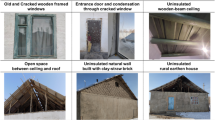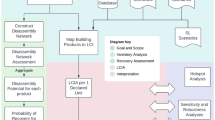Abstract
Building energy modeling, also known as building energy simulation, has developed rapidly in recent years and plays a crucial role in building life-cycle analysis. It can be employed in the design phase to predict the energy consumption of different design schemes and evaluate various control and retrofitting measures at the operation stage. In such simulations, it is commonly understood and accepted that the simulated relative differences are more reliable than the predictions of absolute energy results. However, whether this common understanding is true is yet to be thoroughly investigated. In this study, we investigate the simulated relative differences and the extent to which they are affected by the degree of model input deviation. Simulation and Monte Carlo approaches are adopted for the analysis. The results indicate that the simulated relative differences are not as reliable as expected, and the outputs strongly depend on the degree of the model input deviation. When the degree of deviation is less than 15% or the model inputs are within reasonable ranges, the simulated relative differences match the baseline obtained using Monte Carlo simulations. Moreover, the model’s error indicators meet the requirements of the ASHRAE Guideline 14–2014 when the degree of input deviation is below 15%.
Similar content being viewed by others
References
Ahmad M, Culp C (2006). Uncalibrated building energy simulation modeling results. HVAC&R Research, 12: 1141–1155.
ASHRAE (2014). Guideline 14–2014, Measurement of Energy and Demand Savings. Atlanta, GA, USA: American Society of Heating, Ventilating, and Air Conditioning Engineers.
Balaras CA, Gaglia AG, Georgopoulou E, et al. (2007). European residential buildings and empirical assessment of the Hellenic building stock, energy consumption, emissions and potential energy savings. Building and Environment, 42: 1298–1314.
Chong A, Menberg K (2018). Guidelines for the Bayesian calibration of building energy models. Energy and Buildings, 174: 527–547.
Clarke JA, Strachan PA, Pernot C (1993). An approach to the calibration of building energy simulation models. ASHRAE Transactions, 99: 917–927.
Cozza S, Chambers J, Brambilla A, et al. (2021). In search of optimal consumption: A review of causes and solutions to the Energy Performance Gap in residential buildings. Energy and Buildings, 249: 111253.
Crawley DB, Lawrie LK, Winkelmann FC, et al. (2001). EnergyPlus: creating a new-generation building energy simulation program. Energy and Buildings, 33: 319–331.
Deru M, Field K, Studer D, et al. (2011). U.S. Department of Energy Commercial Reference Building Models of the National Building Stock. National Renewable Energy Laboratory, USA.
Dirks JA, Gorrissen WJ, Hathaway JH, et al. (2015). Impacts of climate change on energy consumption and peak demand in buildings: A detailed regional approach. Energy, 79: 20–32.
Domínguez-Muñoz F, Cejudo-López JM, Carrillo-Andrés A (2010). Uncertainty in peak cooling load calculations. Energy and Buildings, 42: 1010–1018.
EIA (2003). 2003 Commercial buildings energy consumption survey, U.S. Energy Information Administration. Available at http://www.eia.doe.gov/emeu/cbecs/cbecs2003/introduction.html.
Eisenhower B, O’Neill Z, Fonoberov VA, et al. (2012). Uncertainty and sensitivity decomposition of building energy models. Journal of Building Performance Simulation, 5: 171–184.
Guo S, Yan D, Gui C (2020). The typical hot year and typical cold year for modeling extreme events impacts on indoor environment: A generation method and case study. Building Simulation, 13: 543–558.
Heo Y, Augenbroe G, Graziano D, et al. (2015). Scalable methodology for large scale building energy improvement: Relevance of calibration in model-based retrofit analysis. Building and Environment, 87: 342–350.
Hopfe CJ, Hensen JLM (2011). Uncertainty analysis in building performance simulation for design support. Energy and Buildings, 43: 2798–2805.
Hosseini M, Bigtashi A, Lee B (2020). A systematic approach in constructing typical meteorological year weather files using machine learning. Energy and Buildings, 226: 110375.
Jin Y, Yan D, Zhang X, et al. (2021). A data-driven model predictive control for lighting system based on historical occupancy in an office building: Methodology development. Building Simulation, 14: 219–235.
Levy S, Steinberg DM (2010). Computer experiments: A review. AStA Advances in Statistical Analysis, 94: 311–324.
Lomas KJ, Eppel H (1992). Sensitivity analysis techniques for building thermal simulation programs. Energy and Buildings, 19: 21–44.
Maile T, Fischer M, Bazjanac V (2007). Building energy performance simulation tools-a life-cycle and interoperable perspective. Center for Integrated Facility Engineering (CIFE) Working Paper, Stanford University.
Manfren M, Aste N, Moshksar R (2013). Calibration and uncertainty analysis for computer models—A meta-model based approach for integrated building energy simulation. Applied Energy, 103: 627–641.
McKay MD, Beckman RJ, Conover WJ (1979). Comparison of three methods for selecting values of input variables in the analysis of output from a computer code. Technometrics, 21: 239–245.
Monetti V, Davin E, Fabrizio E, et al. (2015). Calibration of building energy simulation models based on optimization: a case study. Energy Procedia, 78: 2971–2976.
Reddy TA (2006). Literature review on calibration of building energy simulation programs: uses, problems, procedures, uncertainty, and tools. ASHRAE Transactions, 112(1): 226–240.
Romani Z, Draoui A, Allard F (2022). Metamodeling and multicriteria analysis for sustainable and passive residential building refurbishment: A case study of French housing stock. Building Simulation, 15: 453–472.
Seem JE, Armstrong PR, Hancock CE (1989). Algorithms for predicting recovery time from night setback. ASHRAE Transactions, 95(2): 439–444.
Shen J, Krietemeyer B, Bartosh A, et al. (2021). Green Design Studio: A modular-based approach for high-performance building design. Building Simulation, 14: 241–268.
Silva AS, Ghisi E (2014). Uncertainty analysis of the computer model in building performance simulation. Energy and Buildings, 76: 258–269.
Sun K, Hong T, Taylor-Lange SC, et al. (2016). A pattern-based automated approach to building energy model calibration. Applied Energy, 165: 214–224.
Sun Y, Xue H, Wang W, et al. (2020). Development of an optimal control method of chilled water temperature for constant-speed air-cooled water chiller air conditioning systems. Applied Thermal Engineering, 180: 115802.
Thompson D, Burman E, Mumovic D, et al. (2022). Managing the risk of the energy performance gap in non-domestic buildings. Building Services Engineering Research and Technology, 43: 57–88.
Tian W, Heo Y, de Wilde P, et al. (2018). A review of uncertainty analysis in building energy assessment. Renewable and Sustainable Energy Reviews, 93: 285–301.
Torcellini P, Deru M, Griffith B, et al. (2008). DOE commercial building benchmark models. In: Proceedings of ACEEE Summer Study on Energy Efficiency in Buildings.
Wang D, Pang X, Wang W, et al. (2019). Assessment of the potential of high-performance buildings to achieve zero energy: A case study. Applied Sciences, 9: 775.
Wang D, Pang X, Wang W, et al. (2020). Evaluation of the dynamic energy performance gap of green buildings: Case studies in China. Building Simulation, 13: 1191–1204.
Xie Y, Liu J, Huang T, et al. (2019). Outdoor thermal sensation and logistic regression analysis of comfort range of meteorological parameters in Hong Kong. Building and Environment, 155: 175–186.
Zhang Y, Korolija I (2010). Performing complex parametric simulation with jEPlus. In: Proceedings of the 9th International Conference on Sustainable Energy Technologies (SET2010).
Zhou X, Ren J, An J, et al. (2021). Predicting open-plan office window operating behavior using the random forest algorithm. Journal of Building Engineering, 42: 102514.
Acknowledgements
This work was supported by the “Urban Carbon Neutral” Science and Technology Innovation Fund Project from Beijing University of Technology and Beijing Postdoctoral Research Foundation.
Author information
Authors and Affiliations
Corresponding authors
Rights and permissions
About this article
Cite this article
Wang, D., Pang, X., Wang, W. et al. Evaluation of the relative differences in building energy simulation results. Build. Simul. 15, 1977–1987 (2022). https://doi.org/10.1007/s12273-022-0903-2
Received:
Revised:
Accepted:
Published:
Issue Date:
DOI: https://doi.org/10.1007/s12273-022-0903-2




